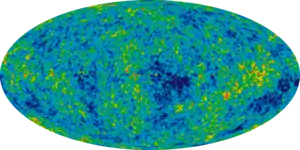Decoupling (cosmology)
In cosmology, decoupling refers to a period in the development of the universe when different types of particles fall out of thermal equilibrium with each other. This occurs as a result of the expansion of the universe, as their interaction rates decrease (and mean free paths increase) up to this critical point. The two verified instances of decoupling since the Big Bang which are most often discussed are photon decoupling and neutrino decoupling, as these led to the cosmic microwave background and cosmic neutrino background, respectively.
| Part of a series on |
| Physical cosmology |
|---|
 |
|
Photon decoupling is closely related to recombination, which occurred about 378,000 years after the Big Bang (at a redshift of z = 1100), when the universe was a hot opaque ("foggy") plasma. During recombination, free electrons became bound to protons (hydrogen nuclei) to form neutral hydrogen atoms. Because direct recombinations to the ground state (lowest energy) of hydrogen are very inefficient, these hydrogen atoms generally form with the electrons in a high energy state, and the electrons quickly transition to their low energy state by emitting photons. Because the neutral hydrogen that formed was transparent to light, those photons which were not captured by other hydrogen atoms were able, for the first time in the history of the universe, to travel long distances. They can still be detected today, although they now appear as radio waves, and form the cosmic microwave background ("CMB"). They reveal crucial clues about how the universe formed.
Photon decoupling
Photon decoupling occurred during the epoch known as the recombination. During this time, electrons combined with protons to form hydrogen atoms, resulting in a sudden drop in free electron density. Decoupling occurred abruptly when the rate of Compton scattering of photons was approximately equal to the rate of expansion of the universe , or alternatively when the mean free path of the photons was approximately equal to the horizon size of the universe . After this photons were able to stream freely, producing the cosmic microwave background as we know it, and the universe became transparent.[1]
The interaction rate of the photons is given by
where is the electron number density, is the electron cross sectional area, and is the speed of light.
In the matter-dominated era (when recombination takes place),
where is the cosmic scale factor. also decreases as a more complicated function of , at a faster rate than .[2] By working out the precise dependence of and on the scale factor and equating , it is possible to show that photon decoupling occurred approximately 380,000 years after the Big Bang, at a redshift of [3] when the universe was at a temperature around 3000 K.
Neutrino decoupling
Another example is the neutrino decoupling which occurred within one second of the Big Bang.[4] Analogous to the decoupling of photons, neutrinos decoupled when the rate of weak interactions between neutrinos and other forms of matter dropped below the rate of expansion of the universe, which produced a cosmic neutrino background of freely streaming neutrinos. An important consequence of neutrino decoupling is that the temperature of this neutrino background is lower than the temperature of the cosmic microwave background.
WIMPs: non-relativistic decoupling
Decoupling may also have occurred for the dark matter candidate, WIMPs. These are known as "cold relics", meaning they decoupled after they became non-relativistic (by comparison, photons and neutrinos decoupled while still relativistic and are known as "hot relics"). By calculating the hypothetical time and temperature of decoupling for non-relativistic WIMPs of a particular mass, it is possible to find their density.[5] Comparing this to the measured density parameter of cold dark matter today of 0.222 0.0026 [6] it is possible to rule out WIMPs of certain masses as reasonable dark matter candidates.[7]
See also
References
- Ryden, Barbara Sue (2003). Introduction to cosmology. San Francisco: Addison-Wesley.
- Kolb, Edward; Turner, Michael (1994). The Early Universe. New York: Westview Press.
- Hinshaw, G.; Weiland, J. L.; Hill, R. S.; Odegard, N.; Larson, D.; Bennett, C. L.; Dunkley, J.; Gold, B.; Greason, M. R.; Jarosik, N. (1 February 2009). "Five-Year Wilkinson Microwave Anisotropy Probe (WMAP) Observations: Data Processing, Sky Maps, and Basic Results". The Astrophysical Journal Supplement Series. 180 (2): 225–245. arXiv:0803.0732. Bibcode:2009ApJS..180..225H. doi:10.1088/0067-0049/180/2/225. S2CID 3629998.
- Longair, M.S. (2008). Galaxy formation (2nd ed.). Berlin: Springer. ISBN 9783540734772.
- Bringmann, Torsten; Hofmann, Stefan (23 April 2007). "Thermal decoupling of WIMPs from first principles". Journal of Cosmology and Astroparticle Physics. 2007 (4): 016. arXiv:hep-ph/0612238. Bibcode:2007JCAP...04..016B. doi:10.1088/1475-7516/2007/04/016.
- Jarosik, N. (4 December 2010). "Seven-Year Wilkinson Microwave Anisotropy Probe (WMAP) Observations: Sky Maps, Systematic Errors, and Basic Results. Table 8". Astrophysical Journal Supplement Series. 192 (2): 14. arXiv:1001.4744. Bibcode:2011ApJS..192...14J. doi:10.1088/0067-0049/192/2/14. S2CID 46171526.
- Weinheimer, C. (2011). "Dark Matter Results from 100 Live Days of XENON100 Data". Physical Review Letters. 107 (13): 131302. arXiv:1104.2549. Bibcode:2011PhRvL.107m1302A. doi:10.1103/physrevlett.107.131302. PMID 22026838. S2CID 9685630.